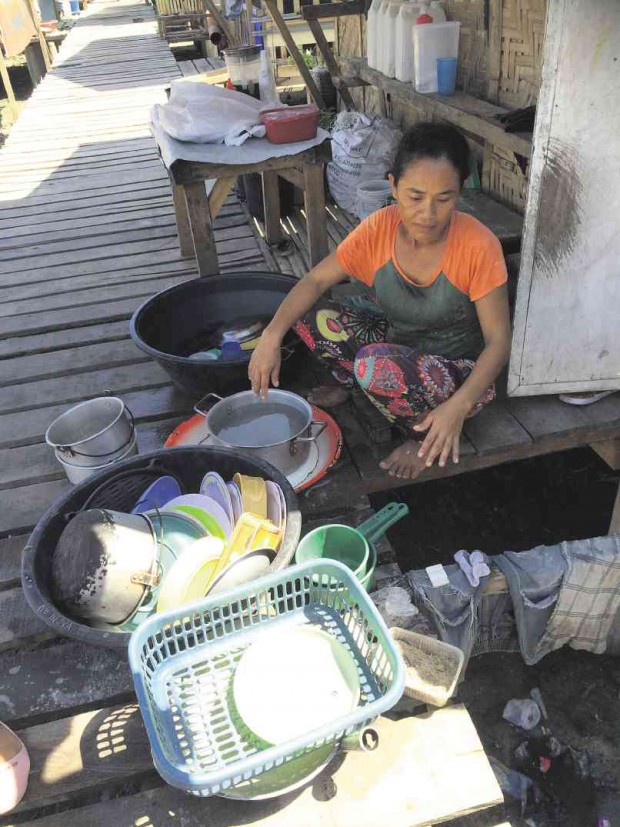Zamboanga folk pray for rain; water rationed

AN EVACUEE has only a pot of water to wash her dishes. Thousands of people displaced by the 2013 siege of Zamboanga City by Moro National Liberation Front rebels are staying in temporary shelters and are affected by water rationing in the city. JULIE ALIPALA/INQUIRER MINDANAO
ZAMBOANGA CITY—Suffering the brunt of the dry spell brought about by the El Niño weather phenomenon, consumers have turned to prayer power to ease the situation amid rising tensions in the neighborhoods over the limited water supply.
“We have performed prayers, particularly the recital of ‘Oratio Imperata’ at the watershed. We are hoping and praying for rain,” said Leonardo Ray Vasquez, the general manager of the Zamboanga City Water District (ZCWD).
From an average flow of about 14,000 cubic meters per hour in previous years, the ZCWD said, supply has gone down to only about 4,000 these days. On Friday, the district started rationing water to about half of its 72,000 consumers, as water at the Pasonanca River dam dropped below critical level.
Zamboanga Archbishop Romulo de la Cruz urged priests and laymen in all 35 churches and 98 chapels here to pray the “Oratio Imperata Ad Petendam Pluviam” for rain.
“We have been requested [to recite] prayers for rain until the Pasonanca water dam is filled enough for the daily consumption of our people,” diocesan priest Mike Ufana told the Inquirer.
“Oratio Imperata” is a 40-line prayer recited for special intentions after each communion, he said. People are asked to kneel and read the prayer aloud.
Those who have less in life were the priority for the water-rationing scheme, Vasquez said.
But as soon as the scheme started after taps barely produced water, some neighbors reportedly began bickering over the basic necessity.
Dry spell until May
“We will deliver tankers to them but on a ration basis because we cannot, at this time, cater to all,” Vasquez said. He pointed out that the dry spell was expected until May but that the water district was trying its best to provide a solution.
At the Buggoc transitory site in Sta. Catalina village, where thousands of people displaced by the 2013 fighting between government soldiers and Moro National Liberation Front members are staying, the meek were forced to give way to those who believe they were more powerful.
The city hosts 11 transitory sites for about 4,000 families displaced by the 2013 rampage of followers of Moro leader Nur Misuari.
Asikal Asiral, a camp leader at Buggoc, said trucks would deliver water outside the gate, “but we are being prevented by home-based villagers from getting our supply until all the other families were finished fetching theirs.”
“Those two blue water tanks were intended for us, but we are powerless,” Asiral said of the plight of those at the transitory sites who are mainly Badjao.
Bickering among evacuees
Rey Amil, a Badjao, told the Inquirer that his people did not want to fight and just allowed the more assertive villagers to take the water intended for the transitory site. “Home-based families are too many, we avoid fighting them,” he said.
Amil said he hopes the water tanks would be placed inside Buggoc next time.
People are also fighting over scarce supply at the Masepla transitory site.
“You cannot blame other families. Those who can fetch more and save more will have more to consume,” said Zarah Bazari, one of the camp leaders.
“We hardly have sufficient water these days. In the past, the water district delivered two to three trucks daily; now, just once every other day,” she said.
Lucky are those who can afford to buy mineral water, Bazari said.
When informed about the situation in the transitory sites, Alejo Rojas Jr., ZCWD assistant general manager, stressed that the “internally displaced families are our priority in water delivery.”
“We are trying our best to deliver but the supply is not enough,” Rojas said.
Situation could get worse
The reality, he said, is the ZCWD also has to ration water to 30 other villages due to the drastic drop in the level of water at the Pasonanca River, the main source of the drinking water supply here.
Unless a good amount of rain drops in the next days, the situation could only get worse, Vasquez said.
Amid the water shortage, the city council has yet to declare a state of calamity, Councilor Kim Elago told the Inquirer.
The ZCWD has already asked the councilors to do so, Councilor Melchor Sadain said. It was endorsed by the City Disaster Risk Reduction and Management Council, said Sheila Belen Covarrubias, city information officer.
The declaration would allow the water firm to institute contingency plans with the use of calamity funds, Covarrubias said.
Mayor Ma. Isabelle Salazar has asked her division chiefs, including the city agriculture officer, “to expedite the conduct of mitigating measures on water and energy conservation.”














